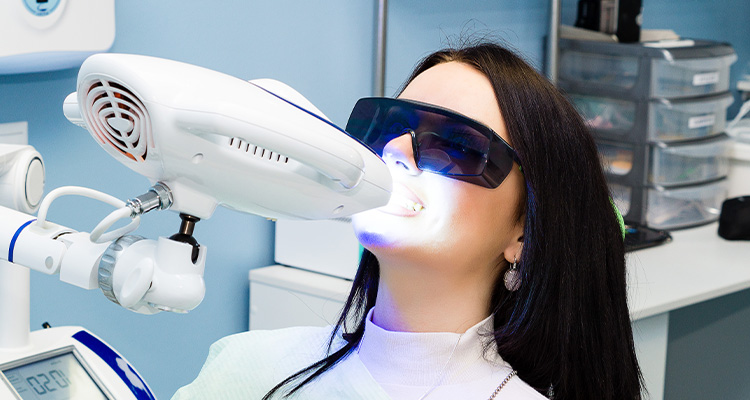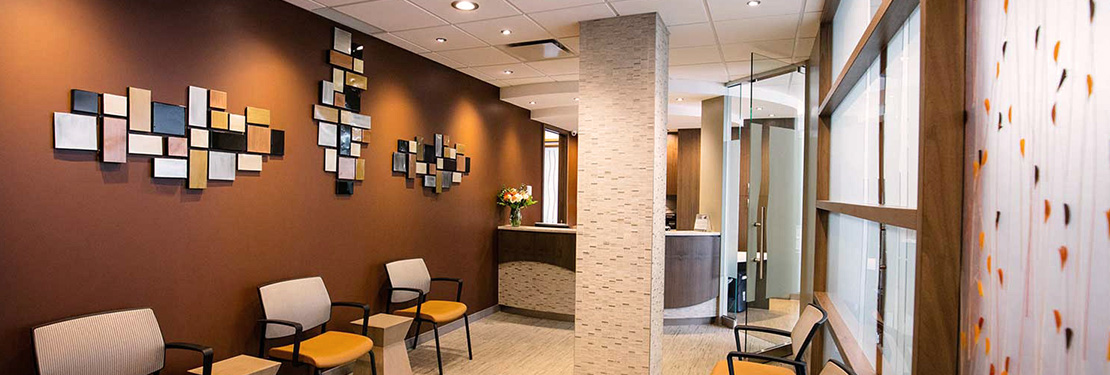Though most teeth are naturally light yellow or light grey, many Canadians want to achieve that perfect pearly white smile. This demand for teeth whitening has spawned a number of whitening products, both for at-home and in-office use.
However, not all whitening products are equally effective. Before you begin any whitening regime, be sure to speak to your dentist.
What Are the Most Popular Teeth Whitening Methods?

Many Canadians opt for at-home whitening treatments such as whitening toothpastes, whitening rinses, or whitening gels or strips. However, more Canadians turning to their dentists to get their teeth professionally whitened. This is because in-office whitening is faster and more effective than current at-home whitening methods.
What’s the “Best” Way to Whiten Your Teeth?
As long as you stay away from products that damage your teeth or irritate your gums, there isn’t really a right way to whiten your teeth. However, at-home products such as whitening toothpaste, white strips, and whitening gel are significantly less effective than the professional teeth whitening procedures offered by dentists.
At-home whitening products have many drawbacks. Whitening toothpastes and rinses can only deal with surface stains, making them ineffective against serious staining. White strips and whitening gels are more effective than toothpastes and rinses, but you will still need to wear them for at least two hours each day, and many products take between ten and twenty days of use before you see visible results.
In-office teeth whitening systems such as the Philips Zoom Whitespeed (available at Ti Dental) offer a significantly quicker and more effective way to whiten your teeth. Most patients enjoy immediate results in as little as one thirty or sixty-minute session, though dramatic results may require several treatments. Since the trays are custom fit to your mouth, your dentist can minimize contact between your gums and the bleaching agent, reducing irritation. The in-office treatments are also able to safely use stronger bleaching agents than their at-home counterparts and may be used with a laser, heat, or special light to turbocharge the whitening process.
What Are Methods to Avoid (and Why)?
In general, you should avoid using at-home whitening trays that are not produced by your dentist. At-home whitening trays may be able to offer you a whiter smile faster than strips or gels, but since the trays are not custom fit, they are more likely to rub and allow the bleaching solution to come into contact with your gums. The rubbing and the bleaching solution can both cause gum irritation.
If you want to whiten your teeth at home using a tray, speak to your dentist. They may be able to create a custom tray for you and provide you with a bleaching agent that is safe to use at home. This custom tray will help prevent irritation.
You should never begin any whitening routine without first speaking to your dentist.
How Does Teeth Whitening Work?

There are two main types of teeth whitening products:
- Surface whiteners: Surface whiteners include whitening toothpaste and whitening gum. These types of teeth whitening products can only address surface stains. To help ensure you don’t inadvertently damage your teeth or gums, you should only use toothpastes that have earned the CDA seal of approval. Brushing your teeth after every meal is one way you can prevent surface stains from building up, leaving your teeth naturally whiter.
- Bleaches: Bleaches include in-office whitening products, at-home tray-based whitening, whitening rinses, whitening strips, and whitening gels. Most bleaching products contain peroxide, which is why they are able to alter your tooth’s natural colour. However, not all types of tooth discoloration will respond well to bleaching. Bleaching relies on prolonged contact with your tooth, which is why most at-home bleaching products require prolonged use and require many applications before you see visible results. In-office treatments are much more effective than at-home bleaching products. Never use a bleaching based tooth whitening product without first speaking to your dentist.
Is Teeth Whitening Safe?
Extensive research and clinical studies have shown that teeth whitening is safe when it is performed under dentist supervision. At-home treatments are also safe when used appropriately.
Some patients report experiencing short term, minor tooth sensitivity and soft tissue irritation. If you experience any pain or discomfort during or after whitening your teeth, let your dentist know. If you are using an at-home product discontinue use and speak to your dentist.
What Are Common Side Effects of Teeth Whitening?
Some patients report experiencing short term, minor tooth sensitivity and soft tissue irritation. If you experience any pain or discomfort during or after whitening your teeth, let your dentist know. If you are using an at-home product discontinue use and speak to your dentist.
Most side effects should disappear within one to three days after treatment.
How Often Should Someone Whiten Their Teeth?
How often you can, and should, whiten your teeth depends on the individual and the product you are using. Speak to your dentist about how frequently you should be whitening your teeth. If you have sensitive teeth, your dentist may suggest you whiten less frequently. If you have dental crowns, fillings, extremely dark stains on your back teeth, or have undergone a root canal, you should avoid using bleaching products until you have consulted with your dentist.
Depending on the severity of your tooth stains and other factors, your dentist may suggest avoiding tooth whitening all together and instead considering other methods such as veneers to achieve the pearly white smile you desire.
If you experience tooth sensitivity or soft tissue irritation during an in-office procedure, let your dentist know so they can check and make sure everything is all right. If you experience these symptoms at home, stop using your whitening product and make an appointment with your dentist.








